
Allergies
Our relationship to the world around us can be divided into two parts; ourselves and everything else that is not us. To protect ourselves from materials that are foreign to us, we have an elaborate defense mechanism called the immune system. On an ongoing basis , twenty-four hours per day, our immune system must determine whether anything outside of our own bodies or within our bodies is harmless or represents some degree of potential danger.
When our immune system determines that any substance e.g., food, pollen, dander, chemical, we have come into contact with is potentially harmful, it gives off a number of substances to protect the body. The most well-known chemical the body secretes related to this is histamine which is given off by a type of white blood cell called a mast cell. Histamine causes the mucus membranes including the eyes, mouth, parts of the lung, colon and small intestine to secrete mucus for protection. Under the influence of histamine, the heart speeds up to help rid the body of the foreign substance and white blood cells increase in number to neutralize the material. This is all well and good except this process produces uncomfortable symptoms such as sneezing, runny nose, watery eyes, asthmatic attacks and coughing. What many do not realize, however, is that a wide variation of other symptoms can also be produced including diarrhea, mucus discharge from the colon, intestinal cramping (as seen in Ulcerative Colitis and Crohn’s Disease), inflammation of the joints as is seen in Rheumatoid Arthritis, eczema, hives, and a myriad of other symptoms.
It is not uncommon for us to interview patients who tell us that they had allergies as a child but that they “outgrew them”. They now, however, are affected by colitis, arthritis, hives, headaches and other chronic problems. They and their doctors have failed to understand that their allergies were not so much outgrown as they were simply converted into a different set of symptoms.
As a health planner and epidemiologist trained at the University of Texas Medical Center and employed by the State of Illinois back in the late 1970’s, I noted that patients with autoimmune issues often experienced a crisis with their health issues during the Spring and Fall when the pollen reach high levels. This association, a causal relationship in my opinion, is largely ignored within medical circles with the prevailing thought that autoimmune disorders are simply etiology or cause unknown.
The medical treatment of allergies involves testing, typically via the skin patch test, the “gold standard” in a medical allergist’s or pediatrician’s office. This form of testing has been utilized for decades (it was done on me when I was eleven years old and that was a long time ago!). In this test a variety of potential allergens are placed into scratches made on the arm or back to see which ones create a reaction, a reddening of the skin known as an erythema. Then based on the test results, allergy shots (desensitization shots) are given over a period usually lasting a number of years, the idea being to accustom the body to the particular allergen or desensitize it.
First, we must recognize that putting a foreign material into a small scratch on the skin is not the same as inhaling or ingesting a material. There is therefore a high degree of false positives and false negatives with this procedure. Secondly, desensitization shots entail numerous office visits over a long period of time at considerable expense. All this would be fine if they worked, but a large proportion of patients will tell you that they received little to no benefit from the shots or that their symptoms simply changed to something else or other allergies developed.
There are also symptomatic allergy treatments both over the counter and prescription. Most of these involve the use of anti-histamines which block the action of histamine. These include common items such as Benadryl and Claritin. In more severe cases, steroids are applied which while suppressing the allergic response, produce a wide range of serious side effects and complications (see article “Problems with Prednisone”). Over time, steroids can increase the patient’s allergic tendencies as the endocrine system is greatly weakened by their usage. In addition, steroids lead to a thinning of the intestinal membrane making the gut more permeable. This allows foreign materials to more easily permeate through the gut lining and initiate an allergic reaction.
Additional observations:
- The number of people in our nation with allergies is dramatically increasing, particularly among children. One of the disorders now seen increasingly are the inter-related diseases of Eosinophilic Esophagitis, Gastritis and Colitis which the medical profession treats by ongoing courses of steroids. There are many contributing factors to this including the lack of exposure of children to the outside world to develop tolerance to foreign materials and the increased use of pharmaceuticals such as antacids which interfere with proper digestion, particularly that of proteins.
- Just as allergies are increasing rapidly so are autoimmune disorders. We consider them to be opposite sides of the same coin and over the past forty-five years I have observed the intimate relationship between the two…a relationship that is important to consider in helping patients to improve their health.
- I would also stress again that a wide variety of symptoms, including skin issues, digestive and intestinal disturbances, fatigue issues, behavioral issues, depression, respiratory issues, and other issues often have important allergic components that are entirely overlooked by traditional and alternative medical practitioners. Read article: “The Diverse and Life Damaging Effects of Seasonal Allergies: Finding a Resolution to Underlying Problems”.
See over fifty video interviews with our patients who successfully reversed allergic disorders.
The Bio-Hygienic Re-Creation System™
The Bio-Hygienic Approach™ focuses on the causal factors behind allergies and autoimmune disorders not simply their suppression by pharmaceutical agents. Allergy identification is part of the process and we utilize specific testing to evaluate both food and inhalant allergies in some patients. An extensive case history is critical to sort out causal factors including genetic tendencies. The case history generally takes a full hour and is just as important as laboratory testing. Keep in mind that allergy testing only reveals what the patient is currently sensitive to not why. It should also be noted that allergies, particularly to foods, will change over time and that eliminating foods from one’s diet often only brings about temporary improvement as new allergies often follow in their place. The why of allergies in each person is just as important as what items they are allergic to.
The immune system interacts intimately with the digestive and endocrine systems and all three deserve special attention in allergic issues. Good digestion is critical to overcoming allergies and autoimmune disorders. Dietary factors must be examined carefully but care must be taken not to take an exclusively diet focused approach. We commonly see patients who have put all their eggs in one basket, in this case the diet basket, and have eliminated more and more foods till there is very little to choose from and the health problems still exist. It is not just the food; it is the way the body processes the food. Carbohydrates must be broken down into glucose, fats into glycerol and fatty acids and proteins into amino acids. If a food is properly digested and broken down into its basic components, allergic reactions are unlikely to occur. Any food, however, can potentially set off an allergic response if mal-digested. Foods with a higher protein content and those foods that are routinely eaten day after day are the most common offenders.
The patient’s endocrine system must be strengthened (unlike the use of steroids by medical physicians which weakens it) so that it is capable of producing the right hormones, in balance with each other, to meet the demands of stress. Blood sugar levels are also important to assess since irregularities in blood glucose can exacerbate allergic tendencies.
Rest and sleep habits must be assessed whereas a tired individual is much more likely to have more severe allergic problems.
Emotional stressors must be evaluated as emotional ups and downs are significant factors in the exacerbation of allergic problems.
In sum, the Bio-Hygienic Approach™, rather than treat allergies, seeks out the causal factors behind them and then creates the right conditions to foster a more balanced, healthy response to the outside world whether the instigating factors be foods, pollens, dander or other foreign materials.
The outcome through such an approach is improved overall health and fewer, less severe allergic responses (see before / after pictures below)…and all this without the use of dangerous drugs. As with any chronic health issue, there is the need for proper evaluation followed by discipline in enacting a full health building program individualized to the patient.
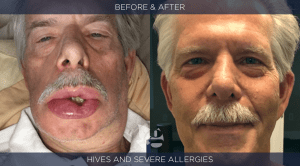
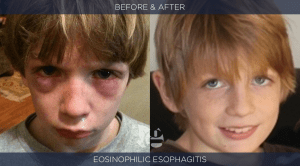

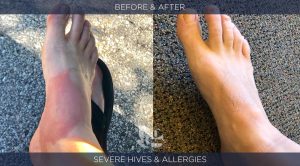
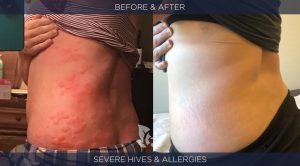
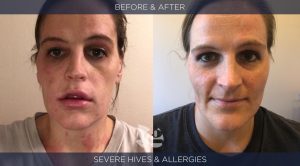
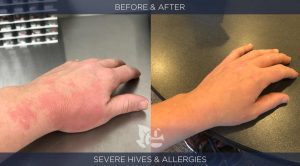
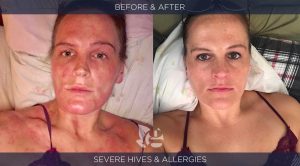
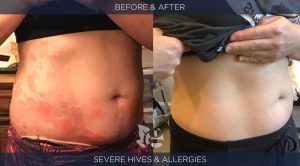
See case studies exemplifying the Bio-Hygienic Approach™ in action.
Related Articles
- Reversing… NOT Treating Asthma
- “The Diverse and Life Damaging Effects of Seasonal Allergies: Finding a Resolution to Underlying Problems”.
- Eosinophilic Esophagitis, Gastritis and Colitis
- Reversing Autoimmune Disease
- Allergies: Obtain Real Improvement Rather than Treating Symptoms
- Problems with Prednisone: Why Inflammation is Not the Enemy
- Crohn’s Disease and Ulcerative Colitis: Your Health Can be Restored!



